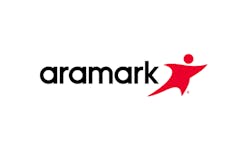Aramark reports strong second-quarter earnings
Aramark reported second-quarter fiscal 2022 results.
Year-over-year summary:
- Revenue +37%; organic revenue +35%.
- Double-digit growth across all segments, led by FSS U.S.
- Revenue at 97% of pre-COVID level; organic revenue at 95% of pre-COVID level
- Operating income up $137 million; adjusted operating income (AOI) up $138 million.
- Operating income margin of 3.7%; AOI margin of 4.5% on a constant-currency basis
- Increased profitability driven by higher sales volume and operational cost management
- EPS increased $0.44 to $0.14; adjusted EPS increased $0.46 to $0.22.
- Positioned for second consecutive year of record-breaking net new business.
- Strong start to fiscal year driven by better-than-expected new account wins
- Robust sales pipeline for the remainder of the year
John Zillmer, Aramark's chief executive officer, said in the announcement: "Success driving our operational, strategic, investment, and cultural initiatives enabled Aramark to deliver double-digit organic revenue growth in each segment. As our financial performance across the business continues to strengthen, I'm encouraged by the record-breaking pace of new client wins, and a sales pipeline for the remainder of the year which we believe puts us on track for a second consecutive year of record-breaking Net New Business performance. None of this could be accomplished without the extraordinary Aramark people around the world who are focused on living our hospitality culture in our client locations and in the communities where we live and work. I couldn't be more proud of this team and all they continue to do."
Second-quarter results
Consolidated revenue was $3.9 billion in the second quarter, an increase of 37% compared to the prior year period. Organic revenue, which adjusts for the effect of currency translation and certain acquisitions, improved 35% year-over-year with double-digit growth in all segments.
An improving base recovery, pricing pass-through and the benefit from new client wins led to consolidated revenue at 97% and organic revenue at 95% of pre-COVID levels.
- FSS United States organic revenue increased 45% compared to the second quarter last year.
- FSS International grew organic revenue 35% year-over-year for the second quarter, reporting ongoing progress in returning to pre-COVID levels. Europe and Canada experienced improved business activity compared to the prior year. Emerging Markets continued its strong growth trajectory led by Latin America. Despite increased lockdown restrictions in the quarter, China delivered growth through net new business, primarily serving healthcare clients. Across the International portfolio, clients are shifting focus to re-openings with government support programs reduced or terminated.
Operating income was $142 million for the second quarter, an increase of $137 million compared to the prior year period. Adjusted operating income was $169 million, a year-over-year increase of $138 million, resulting in an AOI margin of 4.5% on a constant-currency basis. Year-over-year improvement reflected operating leverage from greater revenue levels at existing accounts and the contribution from new accounts, partially offset by the timing lag associated with pricing pass-through related to changes in the rate of inflation, start-up costs from the significant volume of new client wins, and off-program procurement activity as the company managed through the current complex supply chain environment.
- FSS United States effectively managed operating costs across lines of business as base revenue recovered, partially offset by a time lag in recovery of cost inflation in certain businesses, start-up costs for new accounts and off-program procurement activity.
- FSS International also effectively managed operating costs across geographies as base revenue recovered, as well as benefited from previously implemented cost savings actions.
- Uniform & Career Apparel improved operating efficiencies led by early-stage benefits associated with the near-complete implementation of its new Customer Relationship Management (CRM) system, as well as the benefit from net new business and continued base revenue recovery.
- Corporate overhead costs were tightly managed as revenue increased.
